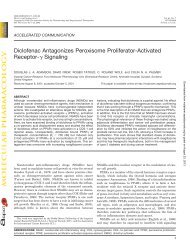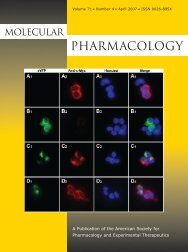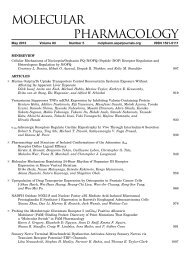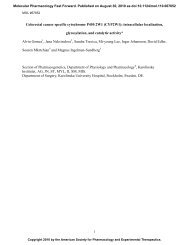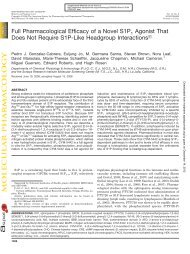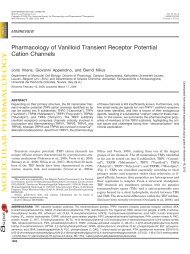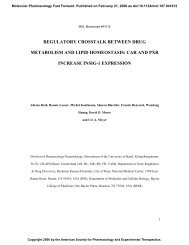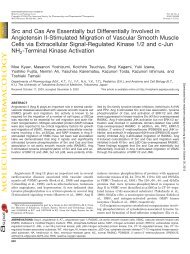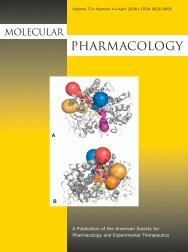The BH3 mimetic ABT-737 Reveals the ... - Molecular Pharmacology
The BH3 mimetic ABT-737 Reveals the ... - Molecular Pharmacology
The BH3 mimetic ABT-737 Reveals the ... - Molecular Pharmacology
Create successful ePaper yourself
Turn your PDF publications into a flip-book with our unique Google optimized e-Paper software.
<strong>Molecular</strong> <strong>Pharmacology</strong> Fast Forward. Published on March 10, 2011 as doi:10.1124/mol.110.070565<br />
1<br />
MOL #70565<br />
<strong>The</strong> <strong>BH3</strong> <strong>mimetic</strong> <strong>ABT</strong>-<strong>737</strong> <strong>Reveals</strong> <strong>the</strong> Dynamic Regulation of BAD,<br />
a Pro-apoptotic Protein of <strong>the</strong> BCL-2 family, by BCL-XL<br />
Zakaria Ezzoukhry, Christophe Louandre, Ca<strong>the</strong>rine François, Zuzana Saidak, Corinne Godin,<br />
Author affiliations :<br />
Jean-Claude Mazière, Antoine Galmiche<br />
Laboratoire de Biochimie, CHU Nord d’Amiens (Z.E., C.L., C.G., J.C.M., A.G.),<br />
Inserm ERI12, EA4292, UFR de Médecine, Université de Picardie Jules Verne, Amiens, France (Z.E.,<br />
C.G., Z.S., J.C.M., A.G.)<br />
Unité de Virologie Clinique et Fondamentale, EA4294, UFR de Médecine et Pharmacie, Université de<br />
Picardie Jules Verne, Amiens, France (C.F.).<br />
Copyright 2011 by <strong>the</strong> American Society for <strong>Pharmacology</strong> and Experimental <strong>The</strong>rapeutics.
Running title: <strong>ABT</strong>-<strong>737</strong> and <strong>the</strong> Regulation of BAD by BCL-XL<br />
2<br />
MOL #70565<br />
Address correspondence to: Antoine Galmiche, MD-PhD, Laboratoire de Biochimie, CHU Nord, 1<br />
Place Victor Pauchet, 80054 Amiens Cedex, France. Tel: 033-(0)3-22668446, Fax: 033-(0)3-<br />
22668593, Email: Galmiche.Antoine@chu-amiens.fr<br />
Number of text pages: 27<br />
Number of Tables: 0<br />
Number of figures: 7<br />
Number of references: 40<br />
Number of words in <strong>the</strong> abstract: 241<br />
Number of words in <strong>the</strong> introduction: 702<br />
Number of words in <strong>the</strong> discussion: 1087<br />
List of non-standard abbreviations: BAD: BCL2-Associated Death promoter, BCL-2: B Cell<br />
Lymphoma-2, BCL-XL: B Cell Lymphoma-XL, DAPI: diamidino-phenylindole, EGF: Epidermal<br />
Growth Factor, MCL-1: Myeloid-Cell Leukemia sequence-1, HSMC: Human Smooth Muscle Cells,<br />
HUVEC: Human Umbilical Vein Endo<strong>the</strong>lial Cells, siRNA: small interfering RNA.
ABSTRACT<br />
3<br />
MOL #70565<br />
<strong>The</strong> proteins of <strong>the</strong> BCL-2 family are important regulators of apoptosis under normal and pathological<br />
conditions. Recently, chemical compounds that block <strong>the</strong> anti-apoptotic proteins of this family have<br />
been introduced, such as <strong>ABT</strong>-<strong>737</strong>, a <strong>BH3</strong>-<strong>mimetic</strong> that neutralises BCL-2 and BCL-XL. In this study,<br />
we used <strong>ABT</strong>-<strong>737</strong> to explore <strong>the</strong> dynamic regulation of BCL-2 proteins in living cells of different<br />
origins. Using <strong>ABT</strong>-<strong>737</strong> as well as RNA interference or <strong>the</strong> application of growth factors, we<br />
examined <strong>the</strong> impact of <strong>the</strong> functional availability of <strong>the</strong> anti-apoptotic proteins BCL-2 and BCL-XL<br />
on <strong>the</strong> BCL-2 network. We report that <strong>ABT</strong>-<strong>737</strong> increases <strong>the</strong> expression of BAD, a pro-apoptotic<br />
partner of <strong>the</strong> proteins BCL-2 and BCL-XL. Our observations indicate that BAD overexpression<br />
induced by <strong>ABT</strong>-<strong>737</strong> results from <strong>the</strong> control of its normally rapid protein turn-over, leading to <strong>the</strong><br />
stabilization of this protein. We demonstrate <strong>the</strong> relevance of BAD post-translational regulation by<br />
BCL-XL to <strong>the</strong> physiological setting using RNA interference against BCL-XL as well as <strong>the</strong><br />
application of Epidermal Growth Factor (EGF), a growth factor that promotes <strong>the</strong> dissociation of BAD<br />
from BCL-XL. Our results highlight a new facet of <strong>the</strong> mode of action of <strong>the</strong> anti-apoptotic proteins<br />
BCL-2 and BCL-XL, consisting in <strong>the</strong> regulation of <strong>the</strong> stability of <strong>the</strong> protein BAD. Finally, our<br />
results shed light on <strong>the</strong> mode of action of <strong>ABT</strong>-<strong>737</strong>, currently <strong>the</strong> best characterized inhibitor of <strong>the</strong><br />
anti-apoptotic proteins of <strong>the</strong> BCL-2 family, and bear important implications regarding its use as an<br />
anti-cancer drug.
INTRODUCTION<br />
4<br />
MOL #70565<br />
Proteins of <strong>the</strong> BCL-2 family are pivotal regulators of apoptosis that share one or more<br />
domains of sequence homology called <strong>the</strong> BCL-2-Homology (BH1-BH4) domains (reviewed in Youle<br />
and Strasser, 2008; Chipuk et al., 2010). BCL-2 proteins are functionally classified into different<br />
subsets, depending on <strong>the</strong>ir pro- or anti-apoptotic effect, and <strong>the</strong> presence of a unique <strong>BH3</strong> or multiple<br />
BH1-BH4 homology domains. Cell sensitivity to apoptosis depends on <strong>the</strong> mutual interactions and<br />
cross-regulations between <strong>the</strong> pro- and anti-apoptotic proteins. <strong>The</strong> pro-apoptotic proteins of <strong>the</strong><br />
“<strong>BH3</strong>-only” subset, including BID, BIM, PUMA or BAD, are upstream regulators that control <strong>the</strong><br />
multi-domain proteins of <strong>the</strong> BCL-2 family, while <strong>the</strong>ir multi-domain counterparts, such as BAX and<br />
BAK, are considered to be core components of <strong>the</strong> mitochondrial apoptotic machinery (Youle and<br />
Strasser, 2008; Chipuk et al., 2010). Under normal conditions, <strong>the</strong> proteins of <strong>the</strong> <strong>BH3</strong>-only subset and<br />
<strong>the</strong> pro-apoptotic multidomain proteins of <strong>the</strong> BCL-2 family are functionally neutralized by <strong>the</strong> anti-<br />
apoptotic proteins of <strong>the</strong> BCL-2 family, such as BCL-2, BCL-XL, or MCL-1. <strong>The</strong> neutralizing effect<br />
of <strong>the</strong> pro-apoptotic proteins is induced by <strong>the</strong> specific interaction of <strong>the</strong> <strong>BH3</strong> domain of <strong>the</strong>se proteins<br />
with a hydrophobic pocket present on <strong>the</strong> surface of <strong>the</strong> anti-apoptotic BCL-2 proteins (Youle and<br />
Strasser, 2008; Chipuk et al., 2010). Recently, compounds with a <strong>BH3</strong> <strong>mimetic</strong> activity have been<br />
developed, with <strong>the</strong> aim of sensitizing cells to apoptosis, principally in <strong>the</strong> context of cancer treatment<br />
(Certo et al., 2006; Van Delft et al., 2006; Letai, 2008). <strong>The</strong> main <strong>BH3</strong> <strong>mimetic</strong> developed to date is<br />
<strong>the</strong> compound <strong>ABT</strong>-<strong>737</strong>, developed by <strong>the</strong> company Abbott, that inhibits <strong>the</strong> anti-apoptotic proteins<br />
BCL-2 and BCL-XL with a reactivity that mimics <strong>the</strong> <strong>BH3</strong>-only protein BAD (Olterdorf et al., 2005;<br />
Lee et al., 2007).<br />
<strong>The</strong> interaction between <strong>the</strong> <strong>BH3</strong>-only protein BAD and <strong>the</strong> anti-apoptotic proteins BCL-2 and<br />
BCL-XL regulates cell sensitivity to apoptosis (Yang et al., 1995; Kelekar et al., 1997; Petros et al.,<br />
2000; Letai et al., 2002; Chen et al., 2005; Kuwana et al., 2005; Kim et al., 2006; Hinds et al., 2007).
5<br />
MOL #70565<br />
As is <strong>the</strong> case for o<strong>the</strong>r <strong>BH3</strong>-only proteins of <strong>the</strong> BCL-2 family, BAD operates as a sentinel and an<br />
upstream regulator of BCL-2 proteins in response to specific death stimuli: BAD is under negative<br />
regulation by trophic stimuli, such as those provided by growth factors present in <strong>the</strong> cell culture<br />
medium (reviewed in Danial, 2008). Serine phosphorylations of BAD play an important role in <strong>the</strong><br />
regulation of this protein: unphosphorylated BAD is able to neutralize BCL-2 and BCL-XL, as seen<br />
upon cellular deprivation of pro-survival signals (Danial, 2008). BAD phosphorylation is a complex<br />
process that involves multiple protagonists, and occurs on distinct positions of <strong>the</strong> molecule in a tied<br />
fashion (Zha et al., 1996; Wang et al., 1996; Scheid et al., 1999; Datta et al., 2000; She et al., 2005).<br />
Based on <strong>the</strong> convergence of several kinase signaling pathways, it has been proposed that BAD<br />
operates as a point of integration of <strong>the</strong> activity of pro-survival kinase pathways (She et al., 2005).<br />
While <strong>the</strong> general principles of <strong>the</strong> regulation of apoptosis by <strong>the</strong> interaction between BCL-2 /<br />
BCL-XL and <strong>the</strong> pro-apoptotic proteins such as BAD are well accepted, <strong>the</strong> dynamic aspects of this<br />
regulation inside living cells remain poorly known. <strong>The</strong> recent introduction of inhibitory compounds,<br />
such as <strong>ABT</strong>-<strong>737</strong>, to date <strong>the</strong> most specific inhibitor of <strong>the</strong> proteins BCL-2 and BCL-XL, offers an<br />
interesting possibility to study this aspect of <strong>the</strong> BCL-2 protein network (van Delft et al., 2006; Lee et<br />
al., 2007; Vogler et al., 2009). Based on our previous observation that <strong>ABT</strong>-<strong>737</strong> increases <strong>the</strong><br />
expression of <strong>the</strong> protein BAD in liver cancer cells (Galmiche et al., 2010), we decided to use <strong>ABT</strong>-<br />
<strong>737</strong> to examine <strong>the</strong> functional consequences of <strong>the</strong> neutralization of BCL-2 and BCL-XL on <strong>the</strong><br />
dynamic regulation of <strong>the</strong> BCL-2 network. Here, we report that <strong>the</strong> neutralization of BCL-XL<br />
profoundly impacts several aspects of <strong>the</strong> regulation of BAD. Our findings highlight <strong>the</strong> dynamic<br />
participation of BAD in <strong>the</strong> BCL-2 protein network, and reveal an aspect of <strong>the</strong> regulation of this<br />
protein that has until now received little attention, i.e. <strong>the</strong> regulation of this protein’s stability. Our<br />
results bear important implications regarding <strong>the</strong> mode of action of <strong>ABT</strong>-<strong>737</strong> and <strong>the</strong> use of <strong>BH3</strong>-<br />
<strong>mimetic</strong>s in oncology.
MATERIAL AND METHODS<br />
6<br />
MOL #70565<br />
Cell culture. All cell lines were maintained at 37°C in a humidified atmosphere with 5% CO2. Huh7,<br />
BxPC3, and HeLa cells were cultured in Dulbecco’s Modified Eagle’s Medium supplemented with<br />
10% fetal calf serum (Jacques Boy, Reims, France), 2 mM glutamine, and penicillin / streptomycin.<br />
Human Smooth Muscle Cells (HSMC) derived from aortic tissue, were purchased from Invitrogen and<br />
cultured in medium 231 supplemented with Smooth Muscle Growth Supplement (all from Invitrogen,<br />
Cergy Pontoise, France). Human Umbilical Vein Endo<strong>the</strong>lial cells (HUVEC) were purchased and<br />
cultured in EBM-2 medium supplemented with EGM-2 (Lonza Biowhittaker, Levallois-Perret,<br />
France).<br />
Reagents. <strong>ABT</strong>-<strong>737</strong> and its inactive enantiomer were kindly provided by Abbott (Abbott Laboratories,<br />
IL, USA) (Oltersdorf et al., 2005). Recombinant human Epidermal Growth Factor (EGF), HA14-1,<br />
Actinomycin D and Cycloheximide were purchased from Sigma (Lyon, France). Sorafenib was a kind<br />
gift from Bayer healthcare (Wayne, NJ). MG132, ALLN (Ac-Leu-Leu-Norleucinal) and Epoxomycin<br />
were purchased from Calbiochem (San Diego, CA). Antibodies raised against BAD (#9292), BAD<br />
phosphorylated on Ser75 (Ser112 of murine BAD, #5284), BAD phosphorylated on Ser99 (Ser136 of<br />
murine BAD, #5286), BAD phosphorylated on Ser118 (Ser155 of murine BAD, #9297), BCLXL<br />
(#2764), BAX (#2772), BAK(#3814), BID (#2002) or BIM (#2933) were from Cell Signaling<br />
Technology (Danvers, MA, USA). Antibodies directed against MCL-1 (sc-819), BCL-XL (7B2.5, sc-<br />
56021), BAD (5E6, sc-81442), 14-3-3 proteins (sc-628 and sc-1657) and Hsp60 (sc-13966) were from<br />
Santa-Cruz (Heidelberg, Germany). Antibodies against β-actin (A5441) and α-tubulin (T6199) were<br />
from Sigma. Secondary antibodies coupled with horseradish-peroxidase were purchased from<br />
Amersham-GE Healthcare (Saclay, France).
7<br />
MOL #70565<br />
Western blot. Complete cell extracts were prepared in RIPA buffer. <strong>The</strong>ir protein concentration was<br />
determined with <strong>the</strong> BCA kit (<strong>The</strong>rmo Fisher Pierce, Brebriere, France). <strong>The</strong> proteins were<br />
precipitated, loaded on SDS-PAGE and transferred to nitrocellulose membranes using standard<br />
procedures. <strong>The</strong> ECL reaction was used for revelation on hyperfilms (Amersham – GE healthcare).<br />
Immunoblots were scanned and quantified using <strong>the</strong> software ImageJ (NIH).<br />
Quantitative PCR. Total RNA was extracted using RNeasy Mini Kit (Qiagen, Courtaboeuf, France)<br />
and reverse-transcribed using High Capacity cDNA Reverse Transcription kit and random hexamer<br />
(Applied Biosystems, Courtaboeuf, France). Amplification was performed with <strong>the</strong> TaqMan Universal<br />
PCR master Mix on an ABI 7900HT Sequence Detection System (Applied) using primers and probe<br />
sets for BAD and human β-actin (TaqMan Gene Expression Assay, Applied).<br />
Cellular fractionation. Mitochondria and cytoplasmic fractions were prepared as previously reported<br />
(Galmiche et al., 2008). Briefly, 5.10 6 Huh7 cells were homogenized in a buffer containing 250 mM<br />
sucrose, 10 mM KCl, 1.5 mM MgCl2, 1 mM EDTA, 1 mM EGTA, 20 mM Hepes-KOH pH7.4,<br />
toge<strong>the</strong>r with protease and phosphatase inhibitors. Mitochondria were recovered in <strong>the</strong> heavy<br />
membrane fraction, after centrifugation of <strong>the</strong> post-nuclear supernatant at 13000 G for 15 min. Equal<br />
amounts of proteins from <strong>the</strong> different fractions were applied on SDS-PAGE.<br />
Immunoprecipitation. Huh7 cells were seeded in dishes of 10 cm diameter and treated as indicated.<br />
After one rinsing in cold PBS, extracts were prepared in a buffer containing 150 mM NaCl, 5 mM<br />
EDTA, 1% CHAPS, 20 mM Hepes-KOH pH7.4, with protease inhibitors and a 10 min centrifugation<br />
step at 15000G. For each condition, 1 mg of proteins was incubated with 1 μg of rabbit anti-BCL-XL<br />
antibody (Cell Signaling) for 4h at 4°C. <strong>The</strong> extracts were <strong>the</strong>n incubated for 2h with protein A<br />
immobilized on Sepharose beads (Sigma). <strong>The</strong> beads were washed 3 times and diluted in Laemmli<br />
sample buffer before <strong>the</strong>ir loading on SDS-PAGE. <strong>The</strong> immunoprecipitates were analyzed by<br />
immunoblotting using mouse monoclonal antibodies raised against BCL-XL and BAD.
8<br />
MOL #70565<br />
RNA interference. Silencer select validated siRNAs directed against BCL-XL (si1922:<br />
GGAACUCUAUGGGAACAAUtt, si1923: GCUGGAGUCAGUUUAGUGAtt), MCL-1 (si8583:<br />
CCAGUAUACUUCUUAGAAAtt), BAD (si1861: GGAGGAUGAGUGACGAGUUtt, si1862:<br />
GCAACGCAGAUGCGGCAAAtt) and negative control (am4635 and am4637) were purchased from<br />
Applied Biosystems. Transfections were performed using <strong>the</strong> siPORT-neoFX reagent (Applied<br />
Biosystems) and Optimem transfection medium (Invitrogen), according to <strong>the</strong> manufacturer’s<br />
instructions.<br />
Cytotoxicity assessment. Cells grown on glass coverslips were processed as previously described<br />
(Galmiche et al., 2010). Nuclei were stained with diamidino-phenylindole (DAPI), and cells were<br />
observed with a Nikon Eclipse TE2000U microscope equipped for fluorescence microscopy.<br />
Statistical Analyses. Data are presented as means + S.D. Student’s t test was used, and a value of<br />
p
RESULTS<br />
9<br />
MOL #70565<br />
<strong>ABT</strong>-<strong>737</strong> increases BAD expression levels in a panel of human cell lines. To examine <strong>the</strong> effect of<br />
BCL-2 / BCLXL neutralization we applied <strong>ABT</strong>-<strong>737</strong> on a panel of different cell lines, and measured<br />
<strong>the</strong> expression levels of <strong>the</strong> members of <strong>the</strong> BCL-2 protein family by immunoblotting (Fig. 1). We<br />
found that <strong>ABT</strong>-<strong>737</strong> induces a massive increase in <strong>the</strong> expression of BAD in all <strong>the</strong> cell lines<br />
examined (Fig. 1A, Suppl. Fig. 1). This increase in <strong>the</strong> expression of BAD occurred progressively over<br />
<strong>the</strong> first 3 hours after exposure to <strong>ABT</strong>-<strong>737</strong>. It was a specific event, because <strong>the</strong> protein levels of most<br />
of <strong>the</strong> o<strong>the</strong>r members of <strong>the</strong> BCL-2 family remained stable at that time point (Fig. 1A). <strong>The</strong> expression<br />
of BIM, a protein of <strong>the</strong> <strong>BH3</strong>-only subset, was also slightly increased after cell exposure to <strong>ABT</strong>-<strong>737</strong>,<br />
although <strong>the</strong> effect was much smaller than with BAD (Fig. 1A). <strong>The</strong> effect of <strong>ABT</strong>-<strong>737</strong> was noticed<br />
irrespective of <strong>the</strong> tissue of origin or <strong>the</strong> transformed status of <strong>the</strong> cells that were examined (Fig. 1B):<br />
<strong>the</strong> expression levels of BAD were increased in cells originating from <strong>the</strong> liver (Huh7), cervix<br />
epi<strong>the</strong>lium (HeLa), pancreas (BXPC3), endo<strong>the</strong>lium (HUVEC) or in human smooth muscle cells<br />
(HSMC) originating from <strong>the</strong> vascular wall. While <strong>ABT</strong>-<strong>737</strong> increased <strong>the</strong> expression levels of BAD<br />
at micromolar concentrations, its inactive enantiomer produced no effect (Fig. 1C). We concluded that<br />
<strong>ABT</strong>-<strong>737</strong> is a potent inducer of BAD protein expression in several types of cultured cells.<br />
<strong>ABT</strong>-<strong>737</strong> stabilizes <strong>the</strong> BAD protein. To explore <strong>the</strong> mechanisms that lead to this increase in <strong>the</strong><br />
expression of BAD, we measured BAD mRNA levels in Huh7 cells exposed to <strong>ABT</strong>-<strong>737</strong> or its<br />
inactive enantiomer for 3h (Fig. 1D). Interestingly, we found that BAD mRNA levels remained stable<br />
in <strong>ABT</strong>-<strong>737</strong>-treated cells (Fig. 1D). To directly address <strong>the</strong> role of transcription in <strong>the</strong> regulation of<br />
BAD, we applied actinomycin D, a blocker of RNA polymerase, at a concentration of 2 µg/ml,<br />
previously reported by us to induce a complete block of transcription in eukaryotic cells (Rolando et<br />
al., 2010). Actinomycin D did not prevent <strong>the</strong> induction of BAD in Huh7 exposed to <strong>ABT</strong>-<strong>737</strong> (Suppl.<br />
Fig. 2), fur<strong>the</strong>r suggesting that transcription did not play an important role in <strong>the</strong> increase in <strong>the</strong>
10<br />
MOL #70565<br />
expression of BAD upon exposure to <strong>ABT</strong>-<strong>737</strong>. We <strong>the</strong>refore envisioned <strong>the</strong> possibility that <strong>ABT</strong>-<strong>737</strong><br />
might regulate <strong>the</strong> expression of BAD at <strong>the</strong> post-transcriptional level and in particular through an<br />
effect on <strong>the</strong> stability of this protein. To measure <strong>the</strong> stability of BAD, we used <strong>the</strong> antibiotic<br />
cycloheximide that blocks protein translation, and we analyzed <strong>the</strong> pace at which <strong>the</strong> expression levels<br />
of BAD decayed. Huh7 cells were treated for 1 hour with <strong>ABT</strong>-<strong>737</strong> or its inactive enantiomer after a<br />
pre-incubation with 50 µM cycloheximide, and <strong>the</strong> corresponding protein extracts were analyzed for<br />
<strong>the</strong>ir content of BAD or <strong>the</strong> o<strong>the</strong>r proteins of <strong>the</strong> BCL-2 family (Fig. 2). We found a striking change in<br />
<strong>the</strong> stability of <strong>the</strong> protein BAD upon <strong>ABT</strong>-<strong>737</strong> exposure: while <strong>the</strong> BAD protein presents a rapid<br />
turn-over in control cells, with a half-life estimated around 1h, this turn-over was clearly abolished<br />
upon cell exposure to <strong>ABT</strong>-<strong>737</strong> (Fig. 2). This stabilization of BAD was a specific effect, since we<br />
noted no effect of <strong>ABT</strong>-<strong>737</strong> on <strong>the</strong> turn-over of <strong>the</strong> o<strong>the</strong>r proteins of <strong>the</strong> BCL-2 family that were tested<br />
(Fig. 2). Interestingly, <strong>ABT</strong>-<strong>737</strong> stabilized BAD at a dose of 1 µM (data not shown), in consistency<br />
with its effect on BAD expression noted earlier (Fig. 1C). We concluded that <strong>ABT</strong>-<strong>737</strong> specifically<br />
prevents <strong>the</strong> rapid turn-over of BAD and stabilizes this protein.<br />
<strong>ABT</strong>-<strong>737</strong> promotes <strong>the</strong> cytosolic accumulation of BAD. Based on a previous report where it was found<br />
that heterodimers formed between BAD and BCL-XL had a high affinity for mitochondrial<br />
membranes (Jeong et al., 2004), we decided to fur<strong>the</strong>r examine <strong>the</strong> impact of <strong>ABT</strong>-<strong>737</strong> on <strong>the</strong><br />
subcellular distribution of BAD and its association with BCL-XL. Complete extracts, cytosolic<br />
fractions, and heavy membrane fractions enriched in mitochondria, were prepared from Huh7 cells<br />
exposed to <strong>ABT</strong>-<strong>737</strong> and analyzed by immunoblotting for <strong>the</strong>ir content of BAD (Fig. 3A). Clearly, <strong>the</strong><br />
cytosolic fraction was considerably enriched in BAD, while a slight decrease in <strong>the</strong> mitochondrial<br />
content of this protein was apparent after <strong>ABT</strong>-<strong>737</strong> treatment (Fig. 3A). We concluded that <strong>ABT</strong>-<strong>737</strong><br />
reduces <strong>the</strong> affinity of BAD for mitochondria in living cells. <strong>The</strong> interaction of BAD with membrane<br />
organelles had previously been reported to be controlled by phosphorylation (Danial, 2008). We<br />
decided to examine <strong>the</strong> phosphorylation status of BAD using antibodies raised against <strong>the</strong> three<br />
positions documented to play <strong>the</strong> main role in its regulation, i.e. Ser75, Ser99 and Ser118 of <strong>the</strong><br />
human molecule (Danial, 2008). We detected a different pattern of phosphorylation of BAD in each of
11<br />
MOL #70565<br />
<strong>the</strong> cell lines that were exposed to <strong>ABT</strong>-<strong>737</strong>: phosphorylated forms of BAD remained undetectable in<br />
Huh7 cells. BAD was phosphorylated at high levels on Ser75 in BXPC3 cells, and at intermediate<br />
levels in HeLa, HUVEC or HSMC cells (Supplementary Figure 3). BAD phosphorylation on Ser118<br />
was not detected under our experimental conditions. We concluded that <strong>ABT</strong>-<strong>737</strong> changes <strong>the</strong><br />
subcellular localization of BAD, while its effect on <strong>the</strong> phosphorylation of BAD is context-specific<br />
and depends on <strong>the</strong> various cell lines or experimental conditions that were applied here. Next, we<br />
tested <strong>the</strong> possibility that a change in <strong>the</strong> association of BAD with proteins of <strong>the</strong> 14-3-3 family might<br />
account for <strong>the</strong> cytosolic accumulation of BAD upon <strong>ABT</strong>-<strong>737</strong> treatment. We performed an<br />
immunoprecipitation of 14-3-3 proteins to examine <strong>the</strong> amount of BAD associated with this family of<br />
cytosolic proteins (Suppl. Fig. 4). We found no evidence of an association between <strong>the</strong>se proteins in<br />
Huh7 cells that had been exposed to <strong>ABT</strong>-<strong>737</strong>, while <strong>the</strong> kinase C-RAF, used here as a positive<br />
control, remained stably associated with 14-3-3 proteins (Suppl. Fig. 4). Finally, we examined <strong>the</strong><br />
effect of <strong>ABT</strong>-<strong>737</strong> on <strong>the</strong> association of BAD with BCL-XL (Fig. 3B). We performed an<br />
immunoprecipitation of BCL-XL from Huh7 exposed to <strong>ABT</strong>-<strong>737</strong> for 3h, and <strong>the</strong> levels of BAD<br />
present in <strong>the</strong> immunoprecipitate were examined by immunoblotting. We found that <strong>ABT</strong>-<strong>737</strong><br />
prevents <strong>the</strong> interaction between BCL-XL and BAD, in agreement with <strong>the</strong> previous biochemical<br />
characterization of this drug (Oltersdorf et al., 2005) (Fig. 3B). We concluded that <strong>ABT</strong>-<strong>737</strong> induces<br />
<strong>the</strong> cytosolic accumulation of <strong>the</strong> molecule BAD in a free, unliganded, form.<br />
BCL-XL regulates <strong>the</strong> expression of BAD. To check whe<strong>the</strong>r <strong>the</strong> neutralization of BCL-XL accounts<br />
for <strong>the</strong> effect of <strong>ABT</strong>-<strong>737</strong> on BAD, we combined several approaches. First, we tested ano<strong>the</strong>r inhibitor<br />
of <strong>the</strong> anti-apoptotic proteins of <strong>the</strong> BCL-2 family structurally unrelated to <strong>ABT</strong>-<strong>737</strong>, <strong>the</strong> compound<br />
HA14-1 (Wang et al., 2000). HA14-1 also induced an overexpression of BAD at <strong>the</strong> protein level,<br />
albeit with somewhat lower potency than <strong>ABT</strong>-<strong>737</strong> (Suppl. Fig. 5). More importantly, we performed<br />
RNA interference experiments directed against anti-apoptotic proteins of <strong>the</strong> BCL-2 family in Huh7<br />
cells. While <strong>ABT</strong>-<strong>737</strong> can target BCL-XL and BCL-2, we did not detect any expression of BCL-2 in<br />
Huh7 cells, and we consequently decided to explore <strong>the</strong> role of BCL-XL in <strong>the</strong> regulation of BAD. We<br />
compared <strong>the</strong> effect of two independent siRNA targeting sequences of BCL-XL with control siRNAs
12<br />
MOL #70565<br />
directed against irrelevant sequences or against MCL1, ano<strong>the</strong>r pro-survival member of <strong>the</strong> BCL-2<br />
family that is not targeted by <strong>ABT</strong>-<strong>737</strong>, on BAD expression levels (Oltersdorf et al., 2005) (Fig. 4A).<br />
Strikingly, <strong>the</strong> two siRNAs targeting BCL-XL were found to specifically increase BAD expression,<br />
and <strong>the</strong>refore independently reproduced <strong>the</strong> effect of <strong>ABT</strong>-<strong>737</strong> (Fig. 4A). To check <strong>the</strong> possibility that<br />
transcriptional mechanisms might account for <strong>the</strong> variations in <strong>the</strong> expression of BAD, we measured<br />
BAD mRNA levels using quantitative PCR. We found no increase in BAD mRNA expression levels<br />
in cells treated with BCL-XL siRNA, clearly indicating that a post-transcriptional mechanism explains<br />
<strong>the</strong> increase in BAD protein expression in <strong>the</strong>se cells (Suppl. Fig. 6). A fur<strong>the</strong>r indication that BAD<br />
expression levels are regulated post-translationally was obtained with <strong>the</strong> application of chemical<br />
inhibitors of <strong>the</strong> proteasome on Huh7 cells. Three non-structurally related inhibitors of <strong>the</strong> proteasome<br />
(MG132, ALLN and Epoxomycin) were applied on Huh7 for a short period of time, and found to<br />
clearly increase BAD expression levels, confirming <strong>the</strong> importance of <strong>the</strong> regulation of this protein at<br />
<strong>the</strong> level of <strong>the</strong> protein turn-over (Suppl. Fig. 7). To fur<strong>the</strong>r examine <strong>the</strong> possibility that <strong>the</strong><br />
neutralization of BCL-XL accounted for <strong>the</strong> overexpression of BAD, we examined <strong>the</strong> effect of <strong>ABT</strong>-<br />
<strong>737</strong> on cells in which BCL-XL levels were reduced by RNA interference (Fig. 4B). We noted no<br />
additive increase in <strong>the</strong> expression of BAD, after exposure to <strong>ABT</strong>-<strong>737</strong> in cells where BCL-XL<br />
expression was reduced by RNA interference (Fig. 4B). <strong>The</strong>se findings fur<strong>the</strong>r suggested <strong>the</strong><br />
specificity of <strong>the</strong> effects of <strong>ABT</strong>-<strong>737</strong> that we had reported, and we concluded that <strong>the</strong> neutralization of<br />
BCL-XL most likely accounts for <strong>the</strong> effect of <strong>ABT</strong>-<strong>737</strong> on <strong>the</strong> turn-over of BAD.<br />
Physiological and Pharmacological Relevance to <strong>the</strong> regulation of BAD. To examine <strong>the</strong><br />
consequences of our findings in a physiologically relevant setting, we turned our attention to EGF, a<br />
growth factor that potently activates <strong>the</strong> RAF-MEK-ERK kinase cascade and promotes <strong>the</strong><br />
phosphorylation of BAD on Ser75 (She et al., 2005). It had been reported previously that BAD<br />
phosphorylation induced by EGF disrupts <strong>the</strong> complexes formed between BCL-XL and BAD (Scheid<br />
et al., 1999). We <strong>the</strong>refore exposed Huh7 cells to EGF (15 ng/ml) for 1h and examined <strong>the</strong> protein and<br />
mRNA levels of BAD, by immunoblotting and quantitative PCR, respectively (Fig. 5). We noticed<br />
that EGF induced a clear increase in BAD protein levels without altering its mRNA levels (Fig. 5A,
13<br />
MOL #70565<br />
5B). <strong>The</strong> increase in BAD expression observed after EGF exposure was dependent on <strong>the</strong> activation of<br />
intra-cellular kinase cascades because it was blocked by sorafenib, an inhibitor of <strong>the</strong> RAF kinase<br />
family (Fig. 5A). To rule out a possible contribution of a block of translation in <strong>the</strong>se effects of<br />
sorafenib, as was for example observed with MCL-1 (Rahmani et al., 2005), we directly measured <strong>the</strong><br />
stability of <strong>the</strong> BAD protein using cycloheximide (Fig. 5C). <strong>The</strong> results clearly showed that BAD<br />
phosphorylation, which controls <strong>the</strong> ability of this protein to associate with BCL-XL, regulates BAD<br />
protein turn-over in Huh7 cells (Fig. 5C).<br />
To fur<strong>the</strong>r demonstrate <strong>the</strong> relevance of our findings, we decided to examine <strong>the</strong> role of BAD<br />
in <strong>the</strong> cytotoxic effects of <strong>ABT</strong>-<strong>737</strong> on cancer cells. <strong>ABT</strong>-<strong>737</strong> exerts modest cytotoxic effects when it<br />
is applied on cancer cells as a single agent (Oltersdorf et al., 2005), but a potent synergistic pro-<br />
apoptotic effect results from its co-application with oncogenic kinase inhibitors (Cragg et al., 2008;<br />
Cragg et al., 2009; Galmiche et al., 2010; Hikita et al., 2010). Considering that BAD operates as a<br />
point of integration of <strong>the</strong> activity of important pro-survival kinases in cancer cells (She et al., 2005),<br />
we reasoned that <strong>the</strong> induction of BAD by <strong>BH3</strong> <strong>mimetic</strong>s, such as <strong>ABT</strong>-<strong>737</strong>, might partially explain<br />
this synergy. To explore <strong>the</strong> pharmacological relevance of <strong>the</strong> induction of BAD, we decided to<br />
examine <strong>the</strong> role of BAD in <strong>the</strong> cytotoxicity of <strong>ABT</strong>-<strong>737</strong> co-applied with sorafenib on hepatocellular<br />
carcinoma cells (Galmiche et al., 2010; Hikita et al., 2010). Huh7 cells in culture were transfected with<br />
BAD specific siRNAs, according to a previously reported procedure (Galmiche et al., 2010). After 48h<br />
of exposure to <strong>the</strong> siRNAs, cells were treated with <strong>ABT</strong>-<strong>737</strong> and sorafenib (both applied at 10 μM and<br />
maintained for 3h) and <strong>the</strong> percentage of dead cells was evaluated by counting <strong>the</strong> number of cells<br />
with condensed chromatin after a DAPI staining under a microscope (Fig. 6). In our experimental<br />
conditions, we noticed that a 2 fold decrease in <strong>the</strong> expression of BAD significantly reduced <strong>the</strong><br />
cytotoxic effect of <strong>ABT</strong>-<strong>737</strong> and sorafenib (Fig. 6). We concluded that BAD plays a role in <strong>the</strong><br />
cytotoxicity of <strong>ABT</strong>-<strong>737</strong> upon co-application of this <strong>BH3</strong> <strong>mimetic</strong> with a blocker of oncogenic<br />
kinases, such as sorafenib.
DISCUSSION<br />
14<br />
MOL #70565<br />
<strong>The</strong> proteins of <strong>the</strong> BCL-2 family are pivotal regulators of apoptosis and multiple aspects of<br />
cell physiology. In <strong>the</strong> present report, we took advantage of <strong>the</strong> recently developed inhibitor of <strong>the</strong><br />
anti-apoptotic proteins of <strong>the</strong> BCL-2 family, <strong>the</strong> <strong>BH3</strong>-<strong>mimetic</strong> <strong>ABT</strong>-<strong>737</strong>, to examine in a dynamic<br />
fashion how <strong>the</strong> anti-apoptotic proteins BCL-2 and BCL-XL regulate one of <strong>the</strong>ir pro-apoptotic<br />
binding partners, BAD. BAD is an important member of <strong>the</strong> <strong>BH3</strong>-only subset of pro-apoptotic BCL-2<br />
proteins that plays a pivotal role as an apoptosis sensitizer and a regulator of metabolism in <strong>the</strong> liver<br />
and pancreas (Danial, 2008). We report <strong>the</strong> dramatic consequences of <strong>the</strong> application of <strong>ABT</strong>-<strong>737</strong> on<br />
<strong>the</strong> expression and regulation of BAD. Our results bear important consequences regarding <strong>the</strong> cellular<br />
mode of action of <strong>ABT</strong>-<strong>737</strong> as well as <strong>the</strong> regulation of BAD.<br />
Our observations extend <strong>the</strong> current knowledge on <strong>the</strong> mode of action of <strong>ABT</strong>-<strong>737</strong> in <strong>the</strong> cell:<br />
in addition to <strong>the</strong> direct and well-characterized inhibition of BCL-XL by <strong>ABT</strong>-<strong>737</strong> (Oltersdorf et al.,<br />
2005; Lee et al., 2007), our observations suggest that <strong>ABT</strong>-<strong>737</strong> is not only able to neutralize <strong>the</strong> anti-<br />
apoptotic proteins BCL-2 and BCL-XL, but that it could also exert indirect effects on proteins of <strong>the</strong><br />
BCL-2 family. Whe<strong>the</strong>r <strong>the</strong> induction of BAD might contribute to <strong>the</strong> neutralization of BCL-2 and<br />
BCL-XL upon cellular exposure to <strong>ABT</strong>-<strong>737</strong> is currently unclear, since we did not detect an increase<br />
in complex formation between <strong>the</strong>se proteins after treatment with <strong>ABT</strong>-<strong>737</strong>. Never<strong>the</strong>less, our<br />
findings bear important implications concerning <strong>the</strong> <strong>the</strong>rapeutic use of <strong>the</strong> pharmacological inhibitors<br />
of <strong>the</strong> anti-apoptotic BCL-2 proteins. It has recently been noted that <strong>the</strong>se agents produce potent<br />
synergistic pro-apoptotic effects when coapplied with oncogenic kinase inhibitors on cancer cells<br />
(Cragg et al., 2008; Cragg et al., 2009; Galmiche et al., 2010; Hikita et al., 2010). <strong>The</strong> results that we<br />
present in this report suggest that <strong>the</strong> induction of BAD, a <strong>BH3</strong>-only protein that defines a<br />
convergence point for several oncogenic kinases that regulate <strong>the</strong> survival of cancer cells, at least<br />
partially explains this synergy.
15<br />
MOL #70565<br />
Our results also provide interesting new insights on <strong>the</strong> regulation of <strong>the</strong> protein BAD. While<br />
several studies on BAD have put emphasis on <strong>the</strong> role of phosphorylation in <strong>the</strong> regulation of this<br />
protein (reviewed in Danial, 2008), it has remained unclear whe<strong>the</strong>r BAD is constitutively neutralized<br />
by phosphorylation in healthy cells, or whe<strong>the</strong>r it encounters regulated cycles of association /<br />
dissociation with BCL-2 and BCL-XL. Our results suggest that BAD is a protein that constantly<br />
interacts with <strong>the</strong> anti-apoptotic proteins BCL-2 and BCL-XL. Our results also bring useful insights<br />
regarding <strong>the</strong> interaction of BAD with mitochondria. How <strong>the</strong> affinity of BAD for mitochondrial<br />
membranes is regulated is an important question that has been previously explored in vitro using<br />
purified components (Jeong et al., 2004; Hekman et al., 2006). In a recent report, <strong>the</strong> possibility that<br />
BAD might directly possess an affinity for membranes was raised based on <strong>the</strong> lipophilic properties of<br />
<strong>the</strong> carboxy-terminal part of this protein (Hekman et al., 2006). Our observations showing that BAD<br />
accumulates in <strong>the</strong> cytosol of cells exposed to <strong>ABT</strong>-<strong>737</strong> suggest that <strong>the</strong> functionality of <strong>the</strong> anti-<br />
apoptotic proteins of <strong>the</strong> BCL-2 family determines <strong>the</strong> affinity of BAD for mitochondria, and that <strong>the</strong><br />
direct recognition of <strong>the</strong>se organelles’ lipids does not greatly contribute to <strong>the</strong> interaction between<br />
BAD and mitochondria in healthy cells.<br />
Our observations point to an aspect of BAD regulation that has until now received little<br />
attention: <strong>the</strong> control of <strong>the</strong> expression of BAD through <strong>the</strong> modulation of this protein’s stability<br />
(Fueller et al., 2008; Galmiche et al., 2010). Upon BCL-XL neutralization accomplished through <strong>the</strong><br />
administration of a <strong>BH3</strong> <strong>mimetic</strong> or upon RNA interference targeted against BCL-XL, <strong>the</strong> protein<br />
BAD accumulated in a manner that was essentially accounted for by its stabilization. <strong>The</strong> existence of<br />
a regulation of <strong>the</strong> turn-over of BCL-2 proteins through <strong>the</strong> association with <strong>the</strong>ir binding partners is a<br />
property that has already been reported for o<strong>the</strong>r members of <strong>the</strong> BCL-2 family, such as <strong>the</strong> anti-<br />
apoptotic protein MCL1 (Adams et Cooper, 2007; Czabotar et al., 2007) or <strong>the</strong> pro-apoptotic <strong>BH3</strong>-<br />
only protein BIM-EL (Ewing et al., 2007), but that had not yet been reported for BAD. In figure 7, we<br />
propose a model summarizing <strong>the</strong> regulation of BAD with an emphasis on <strong>the</strong> role of BCL-XL. While<br />
our results clearly indicate that <strong>the</strong> interaction of BAD with BCL-XL promotes its turn-over, <strong>the</strong>
16<br />
MOL #70565<br />
molecular mechanisms that control <strong>the</strong> turn-over of BAD upon its association remain incompletely<br />
understood. Future investigations will aim at identifying <strong>the</strong> possible mechanisms, but two non-<br />
mutually exclusive potential explanations can already be envisioned: i) <strong>the</strong> association between BAD<br />
and BCL-XL could expose some sequences of BAD involved in this protein’s turn-over. It is likely to<br />
have a strong impact on <strong>the</strong> folding of BAD, because this protein has been previously reported to be<br />
intrinsically unfolded (Hinds et al., 2007). We previously reported <strong>the</strong> presence of two PEST<br />
sequences, known to exert a destabilizing effect on proteins, in BAD (Fueller et al., 2008). <strong>The</strong><br />
conformation and / or <strong>the</strong> surface exposure of <strong>the</strong>se sequences might change upon <strong>the</strong> interaction of<br />
BAD with BCL-XL; ii) alternatively, <strong>the</strong> association of BAD with BCL-XL might regulate <strong>the</strong> turn-<br />
over BAD by modulating its sub-cellular localization or its proximity with <strong>the</strong> molecular machinery<br />
involved in BAD turn-over.<br />
Irrespective of <strong>the</strong> mechanisms involved, our results suggest that <strong>the</strong> interaction between<br />
BCL-XL and BAD impacts <strong>the</strong> regulation of BAD beyond <strong>the</strong> simple mutual neutralization, by<br />
controlling <strong>the</strong> turn-over of this <strong>BH3</strong>-only protein, an observation that had to our knowledge not been<br />
previously reported. <strong>The</strong>se findings bear important implications for <strong>the</strong> control of apoptosis in <strong>the</strong><br />
context of tumorigenesis. Resistance to apoptosis is a fundamental property of tumor cells, and<br />
alterations of <strong>the</strong> expression of <strong>the</strong> proteins of <strong>the</strong> BCL-2 family frequently contribute to this<br />
resistance (Hanahan and Weinberg, 2000; Letai, 2008; Yip and Reed, 2008; Frenzel et al., 2009). Our<br />
finding that BCL-XL regulates BAD protein stability could partially explain why in tumors that<br />
overexpress BCL-XL, such as hepatocellular carcinoma, BAD expression is reduced through post-<br />
translational mechanisms (Takehara et al., 2001; Galmiche et al., 2010). Based on <strong>the</strong> observations<br />
that we present in this report as well as those published in previous studies, we suggest that <strong>the</strong> control<br />
of protein stability is an important facet of BCL-2 regulation that is controlled via mutual interactions<br />
between BCL-2 proteins. Collectively, our findings illustrate how <strong>the</strong> use of <strong>the</strong> novel reagents with a<br />
<strong>BH3</strong> <strong>mimetic</strong> mode of action helps <strong>the</strong> investigation of <strong>the</strong> dynamic aspects of <strong>the</strong> regulation of BCL-<br />
2 proteins inside intact cells.
ACKNOWLEDGEMENTS<br />
17<br />
MOL #70565<br />
We thank <strong>the</strong> members of <strong>the</strong> laboratory of Biochemistry of <strong>the</strong> CHU d’Amiens for <strong>the</strong>ir support. We<br />
are also grateful for <strong>the</strong> support of <strong>the</strong> Comité de l’Aisne de la Ligue contre le Cancer and <strong>the</strong> Conseil<br />
Régional de Picardie.<br />
AUTHORSHIP CONTRIBUTION<br />
Participated in research design: Ezzoukhry, Galmiche.<br />
Conducted experiments: Ezzoukhry, Louandre, François, Godin.<br />
Performed data analysis: Ezzoukhry, Galmiche.<br />
Wrote or contributed to <strong>the</strong> writing of <strong>the</strong> manuscript: Saidak, Galmiche.<br />
O<strong>the</strong>r: Mazière acquired funding and critically read <strong>the</strong> manuscript.
REFERENCES<br />
18<br />
MOL #70565<br />
Adams KW, and Cooper GM (2007) Rapid turnover of mcl-1 couples translation to cell survival and<br />
apoptosis. J Biol Chem 282: 6192-6200.<br />
Certo M, Del Gaizo Moore V, Nishino M, Wei G, Korsmeyer S, Armstrong SA, and Letai A (2006)<br />
Mitochondria primed by death signals determine cellular addiction to antiapoptotic BCL-2 family<br />
members. Cancer Cell 9: 351-65.<br />
Chen L, Willis SN, Wei A, Smith BJ, Fletcher JI, Hinds MG, Colman PM, Day CL, Adams JM, and<br />
Huang DC (2005) Differential Targeting of Prosurvival Bcl-2 Proteins by <strong>The</strong>ir <strong>BH3</strong>-Only Ligands<br />
Allows Complementary Apoptotic Function. Mol Cell 17: 393-403.<br />
Chipuk JE, Moldoveanu T, Llambi F, Parsons MJ, and Green DR (2010) <strong>The</strong> BCL-2 family reunion.<br />
Mol Cell 37: 299-310.<br />
Cragg MS, Jansen ES, Cook M, Harris C, Strasser A, and Scott CL (2008) Treatment of B-RAF<br />
mutant human tumor cells with a MEK inhibitor requires Bim and is enhanced by a <strong>BH3</strong> <strong>mimetic</strong>. J<br />
Clin Invest 118: 3651-9.<br />
Cragg MS, Harris C, Strasser A, and Scott CL (2009) Unleashing <strong>the</strong> power of inhibitors of oncogenic<br />
kinases through <strong>BH3</strong> <strong>mimetic</strong>s. Nat Rev Cancer 9: 321-6.<br />
Czabotar PE, Lee EF, van Delft MF, Day CL, Smith BJ, Huang DC, Fairlie WD, Hinds MG, and<br />
Colman PM (2007) Structural insights into <strong>the</strong> degradation of Mcl-1 induced by <strong>BH3</strong> domains. Proc<br />
Natl Acad Sci USA 104: 6217-22.
19<br />
MOL #70565<br />
Danial NN (2008) BAD: undertaker by night, candyman by day. Oncogene 27 (Suppl. 1): S53-70.<br />
Datta SR, Katsov A, Hu L, Petros A, Fesik SW, Yaffe MB, and Greenberg ME (2000) 14-3-3 proteins<br />
and survival kinases cooperate to inactivate BAD by <strong>BH3</strong> domain phosphorylation. Mol Cell 6: 41-<br />
51.<br />
Ewings KE, Hadfield-Moorhouse K, Wiggins CM, Wickenden JA, Balmanno K, Gilley R, Degenhardt<br />
K, White E, and Cook SJ (2007) ERK1/2-dependent phosphorylation of BimEL promotes its rapid<br />
dissociation from Mcl-1 and Bcl-xL. EMBO J 26: 2856-67.<br />
Frenzel A, Grespi F, Chmelewskij W, and Villunger A. (2009) Bcl2 family proteins in carcinogenesis<br />
and <strong>the</strong> treatment of cancer. Apoptosis 14: 584-96.<br />
Fueller J, Becker M, Sienerth AR, Fischer A, Hotz C, and Galmiche A (2008) C-RAF activation<br />
promotes BAD poly-ubiquitylation and turn-over by <strong>the</strong> proteasome. Biochem Biophys Res Commun<br />
370: 552-6.<br />
Galmiche A, Fueller J, Santel A, Krohne G, Wittig I, Doye A, Rolando M, Flatau G, Lemichez E, and<br />
Rapp UR (2008) Isoform-specific interaction of C-RAF with mitochondria. J Biol Chem 283: 14857-<br />
66.<br />
Galmiche A, Ezzoukhry Z, François C, Louandre C, Sabbagh C, Nguyen-Khac E, Descamps V,<br />
Trouillet N, Godin C, Regimbeau JM, Joly JP, Barbare JC, Duverlie G, Mazière JC, and Chatelain D<br />
(2010) BAD, a pro-apoptotic member of <strong>the</strong> BCL2 family, is a potential <strong>the</strong>rapeutic target in<br />
Hepatocellular Carcinoma. Mol Cancer Res 8: 1116-25.<br />
Hanahan D, and Weinberg RA (2000) <strong>The</strong> hallmarks of cancer. Cell 100: 57-70.
20<br />
MOL #70565<br />
Hekman M, Albert S, Galmiche A, Rennefahrt UE, Fueller J, Fischer A, Puehringer D, Wiese S, and<br />
Rapp UR (2006) Reversible membrane interaction of BAD requires two C-terminal lipid binding<br />
domains in conjunction with 14-3-3 protein binding. J Biol Chem 281: 17321-36.<br />
Hikita H, Takehara T, Shimizu S, Kodama T, Shigekawa M, Iwase K, Hosui A, Miyagi T, Tatsumi T,<br />
Ishida H, Li W, Kanto T, Hiramatsu N, and Hayashi N (2010) <strong>The</strong> Bcl-xL inhibitor, <strong>ABT</strong>-<strong>737</strong>,<br />
efficiently induces apoptosis and suppresses growth of hepatoma cells in combination with sorafenib.<br />
Hepatology 52:1310-21.<br />
Hinds MG, Smits C, Fredericks-Short R, Risk JM, Bailey M, Huang DC, and Day CL (2007) Bim,<br />
Bad and Bmf: intrinsically unstructured <strong>BH3</strong>-only proteins that undergo a localized conformational<br />
change upon binding to prosurvival Bcl-2 targets. Cell Death Differ 14: 128-36.<br />
Jeong SY, Gaume B, Lee YJ, Hsu YT, Ryu SW, Yoon SH, and Youle RJ (2004) Bcl-x(L) sequesters<br />
its C-terminal membrane anchor in soluble, cytosolic homodimers. EMBO J 23: 2146-55.<br />
Kelekar A, Chang BS, Harlan JE, Fesik SW, and Thompson CB (1997) Bad is a <strong>BH3</strong> domain-<br />
containing protein that forms an inactivating dimer with Bcl-XL. Mol Cell Biol 17: 7040-6.<br />
Kim H, Rafiuddin-Shah M, Tu HC, Jeffers JR, Zambetti GP, Hsieh JJ, and Cheng EH (2006)<br />
Hierarchical regulation of mitochondrion-dependent apoptosis by BCL-2 subfamilies. Nat Cell Biol 8:<br />
1348-58.<br />
Kuwana T, Bouchier-Hayes L, Chipuk JE, Bonzon C, Sullivan BA, Green DR, and Newmeyer DD<br />
(2005) <strong>BH3</strong> domains of <strong>BH3</strong>-only proteins differentially regulate Bax-mediated mitochondrial<br />
membrane permeabilization both directly and indirectly. Mol Cell 17: 525-35.
21<br />
MOL #70565<br />
Lee EF, Czabotar PE, Smith BJ, Deshayes K, Zobel K, Colman PM, and Fairlie WD (2007) Crystal<br />
structure of <strong>ABT</strong>-<strong>737</strong> complexed with Bcl-xL: implications for selectivity of antagonists of <strong>the</strong> Bcl-2<br />
family. Cell Death Differ 14: 1711-3.<br />
Letai, A., Bassik, M.C., Walensky, L.D., Sorcinelli, M.D., Weiler, S., and Korsmeyer, S.J. (2002)<br />
Distinct <strong>BH3</strong> domains ei<strong>the</strong>r sensitize or activate mitochondrial apoptosis, serving as prototype cancer<br />
<strong>the</strong>rapeutics. Cancer Cell 2 (3):183-92.<br />
Letai AG (2008) Diagnosing and exploiting cancer's addiction to blocks in apoptosis. Nat Rev Cancer<br />
8: 121-32.<br />
Oltersdorf T, Elmore SW, Shoemaker AR, Armstrong RC, Augeri DJ, Belli BA, Bruncko M,<br />
Deckwerth TL, Dinges J, Hajduk PJ, Joseph MK, Kitada S, Korsmeyer SJ, Kunzer AR, Letai A, Li C,<br />
Mitten MJ, Nettesheim DG, Ng S, Nimmer PM, O'Connor JM, Oleksijew A, Petros AM, Reed JC,<br />
Shen W, Tahir SK, Thompson CB, Tomaselli KJ, Wang B, Wendt MD, Zhang H, Fesik SW, and<br />
Rosenberg SH (2005) An inhibitor of Bcl-2 family proteins induces regression of solid tumours.<br />
Nature 435: 677-81.<br />
Petros AM, Nettesheim DG, Wang Y, Olejniczak ET, Meadows RP, Mack J, Swift K, Matayoshi ED,<br />
Zhang H, Thompson CB, and Fesik SW (2000) Rationale for Bcl-xL/Bad peptide complex formation<br />
from structure, mutagenesis, and biophysical studies. Protein Sci 9: 2528-34.<br />
Rahmani M, Davis EM, Bauer C, Dent P, and Grant S (2005) Apoptosis induced by <strong>the</strong> kinase<br />
inhibitor BAY 43-9006 in human leukemia cells involves down-regulation of Mcl-1 through inhibition<br />
of translation. J Biol Chem 280: 35217-27.
22<br />
MOL #70565<br />
Rolando M, Stefani C, Flatau G, Auberger P, Mettouchi A, Mhlanga M, Rapp U, Galmiche A, and<br />
Lemichez E (2010) Transcriptome dysregulation by anthrax lethal toxin plays a key role in induction<br />
of human endo<strong>the</strong>lial cell cytotoxicity. Cell Microbiol 12: 891-905.<br />
Scheid MP, Schubert KM, and Duronio V (1999) Regulation of Bad phosphorylation and association<br />
with Bcl-x(L) by <strong>the</strong> MAPK/Erk kinase. J Biol Chem 274: 31108-13.<br />
She QB, Solit DB, Ye Q, O'Reilly KE, Lobo J, and Rosen N (2005) <strong>The</strong> BAD protein integrates<br />
survival signaling by EGFR/MAPK and PI3K/Akt kinase pathways in PTEN-deficient tumor cells.<br />
Cancer Cell 8: 287-97.<br />
Takehara T, Liu X, Fujimoto J, Friedman SL, and Takahashi H (2001) Expression and role of Bcl-xL<br />
in human hepatocellular carcinomas. Hepatology 34: 55-61.<br />
Van Delft MF, Wei AH, Mason KD, Vandenberg CJ, Chen L, Czabotar PE, Willis SN, Scott CL, Day<br />
CL, Cory S, Adams JM, Roberts AW, and Huang DC (2006) <strong>The</strong> <strong>BH3</strong> <strong>mimetic</strong> <strong>ABT</strong>-<strong>737</strong> targets<br />
selective Bcl-2 proteins and efficiently induces apoptosis via Bak/Bax if Mcl-1 is neutralized. Cancer<br />
Cell 10: 389-99.<br />
Vogler M, Dinsdale D, Dyer MJ, and Cohen GM (2009) Bcl-2 inhibitors: small molecules with a big<br />
impact on cancer <strong>the</strong>rapy. Cell Death Differ 16: 360-7.<br />
Wang HG, Rapp UR, and Reed JC (1996) Bcl-2 targets <strong>the</strong> protein kinase Raf-1 to mitochondria. Cell<br />
87: 629-38.<br />
Wang JL, Liu D, Zhang ZJ, Shan S, Han X, Srinivasula SM, Croce CM, Alnemri ES, and Huang Z<br />
(2000) Structure-based discovery of an organic compound that binds Bcl-2 protein and induces<br />
apoptosis of tumor cells. Proc Natl Acad Sci USA 97: 7124-9.
23<br />
MOL #70565<br />
Yang E, Zha J, Jockel J, Boise LH, Thompson CB, and Korsmeyer SJ (1995) Bad, a heterodimeric<br />
partner for Bcl-XL and Bcl-2, displaces Bax and promotes cell death. Cell 80: 285-91.<br />
Yip KW, and Reed JC (2008) Bcl-2 family proteins and cancer. Oncogene 27: 6398-406.<br />
Youle RJ, and Strasser A (2008) <strong>The</strong> BCL-2 protein family: opposing activities that mediate cell<br />
death. Nat Rev Mol Cell Biol 9: 47-59.<br />
Zha J, Harada H, Yang E, Jockel J, and Korsmeyer SJ (1996) Serine phosphorylation of death agonist<br />
BAD in response to survival factor results in binding to 14-3-3 not BCL-X(L). Cell 87: 619-28.
FOOTNOTES<br />
24<br />
MOL #70565<br />
This work was funded by grants from <strong>the</strong> Ligue Nationale contre le Cancer, comité de l’Aisne [Rôle et<br />
Régulation de la protéine BAD dans le Carcinome Hépatocellulaire]; and from <strong>the</strong> Conseil Régional<br />
de Picardie [Accueil Chercheur de Haut Niveau, MALVIRC 2009]. <strong>The</strong> funders had no role in study<br />
design, data collection and analysis, decision to publish, or preparation of <strong>the</strong> manuscript.
LEGENDS FOR FIGURES<br />
25<br />
MOL #70565<br />
Figure 1: <strong>ABT</strong>-<strong>737</strong> increases <strong>the</strong> expression of BAD protein. A. Time-course induction of BAD in<br />
Huh7 cells treated with <strong>ABT</strong>-<strong>737</strong> (10 µM, 0, 1, 3, 6, 9 hours). B. Quantification of <strong>the</strong> expression of<br />
BAD protein in Huh7, HeLa, BXPC3, HUVEC and HSMC cells exposed to 10 µM of <strong>ABT</strong>-<strong>737</strong> at 0,<br />
1, 3, 6 hours. <strong>The</strong> values are expressed as % of initial content, and are taken from a single<br />
representative experiment. C. Concentration-dependence. Graded concentrations of <strong>ABT</strong>-<strong>737</strong> or its<br />
inactive enantiomer were applied on Huh7 cells for 3 hours, and <strong>the</strong> amount of BAD analyzed by<br />
immunoblotting. <strong>The</strong> values are average of three independent experiments. D. Huh7 cells exposed to<br />
10 µM <strong>ABT</strong>-<strong>737</strong> for 3 hours were analyzed for <strong>the</strong>ir content of BAD mRNA. Results are normalized<br />
with regards to β-Actin mRNA.<br />
Figure 2: <strong>The</strong> increase in expression of BAD by <strong>ABT</strong>-<strong>737</strong> proceeds through <strong>the</strong> stabilization of<br />
<strong>the</strong> BAD protein. Huh7 cells were pre-treated for 30 min with 50 µM cycloheximide and treated with<br />
<strong>ABT</strong>-<strong>737</strong> or its inactive enantiomer (both applied at 10 µM) for 1h. Total protein extracts were<br />
analyzed for <strong>the</strong>ir content of <strong>the</strong> indicated BCL-2 proteins by immunoblotting, and <strong>the</strong> amount of<br />
protein was calculated as a ratio to <strong>the</strong>ir initial content. Data are presented as mean ± SD of 3<br />
independent experiments, with * indicating p< 0.05 compared to control.<br />
Figure 3: <strong>ABT</strong>-<strong>737</strong> promotes <strong>the</strong> cytosolic accumulation of BAD. A. Huh7 exposed to <strong>ABT</strong>-<strong>737</strong> or<br />
its inactive enantiomer (10 μM) for 3h were fractionated as indicated in <strong>the</strong> material and methods, and<br />
equal protein amounts of <strong>the</strong> indicated fractions were analyzed by immunoblotting to determine <strong>the</strong>ir<br />
content of <strong>the</strong> indicated proteins. <strong>The</strong> mitochondrial chaperone HSP60 and tubulin are used as markers
26<br />
MOL #70565<br />
of <strong>the</strong> mitochondrial (mito) and cytosolic (cyt) fractions respectively. This experiment is representative<br />
of three experiments giving comparable results. B. Analysis of <strong>the</strong> complexes formed between BCL-<br />
XL and BAD by immunoprecipitation. Huh7 cells treated with <strong>ABT</strong>-<strong>737</strong> for 3 h (10 µM) were lysed<br />
and BCL-XL was immunoprecipitated. <strong>The</strong> indicated markers were analyzed by immunoblotting. <strong>The</strong><br />
input corresponds to 5% of <strong>the</strong> extract used for each condition of immunoprecipitation, and <strong>the</strong><br />
experiment includes a set of control conditions performed in <strong>the</strong> absence of <strong>the</strong> immunoprecipitating<br />
antibody.<br />
Figure 4: Endogenous BCL-XL modulates <strong>the</strong> expression of BAD. A. RNA interference against<br />
BCL-XL increases BAD protein expression levels. Huh7 cells were transfected with <strong>the</strong> indicated<br />
siRNA and maintained in culture for 3 days. <strong>The</strong> levels of expression of <strong>the</strong> indicated proteins were<br />
subsequently analyzed by immunoblotting. B. Huh7 cells transfected with a ctrl siRNA or a siRNA<br />
directed against BCL-XL were maintained in culture for 48 h, and <strong>ABT</strong>-<strong>737</strong> (10 μM) was applied as<br />
indicated for 3 hours.<br />
Figure 5: Post-transcriptional regulation of BAD after EGF treatment. A. Huh7 cells were serum-<br />
starved for 3h, and exposed to EGF (15 ng/ml) for 1h, ei<strong>the</strong>r alone or in <strong>the</strong> presence of <strong>the</strong> kinase<br />
inhibitor sorafenib (10 µM). <strong>The</strong> levels of expression of <strong>the</strong> indicated proteins were subsequently<br />
analyzed by immunoblotting. Results are from a representative experiment, performed three times<br />
with comparable results. B. mRNA levels of BAD were analyzed in Huh7 cells treated for 1h with<br />
EGF.<br />
Figure 6: RNA interference targeted against BAD protects Huh7 cells from <strong>the</strong> cytotoxic effect<br />
of <strong>the</strong> combination of <strong>ABT</strong>-<strong>737</strong> and sorafenib. A. Huh7 cells were transfected with control or BAD<br />
specific siRNAs and maintained in culture for 48h. Immunoblotting was used to verify <strong>the</strong> reduction in
27<br />
MOL #70565<br />
<strong>the</strong> expression levels of BAD. B. Huh7 cells treated as control or with BAD-specific siRNAs were<br />
exposed for 3h to <strong>ABT</strong>-<strong>737</strong> (10 μM) and sorafenib (10μM), and <strong>the</strong> cytotoxicity was evaluated by<br />
condensed chromatin formation under microscopic examination. Results shown are from a<br />
representative experiment performed in triplicate, with each condition based on at least 500 cells<br />
counted on random fields. *, P < 0.05.<br />
Figure 7: A model for <strong>the</strong> regulation of BAD. <strong>The</strong> model presented here integrates our observations<br />
on <strong>the</strong> control of BAD expression by BCL-XL association. Upon association with BCL-XL, BAD<br />
tends to preferentially target mitochondrial membranes and encounters a rapid turn-over. When BCL-<br />
XL is inhibited by <strong>ABT</strong>-<strong>737</strong>, or when <strong>the</strong> interaction between BAD and BCL-XL is prevented by <strong>the</strong><br />
phosphorylation of BAD (after EGF treatment), <strong>the</strong> turn-over of BAD is prevented and <strong>the</strong> protein<br />
accumulates in <strong>the</strong> cytosol.




